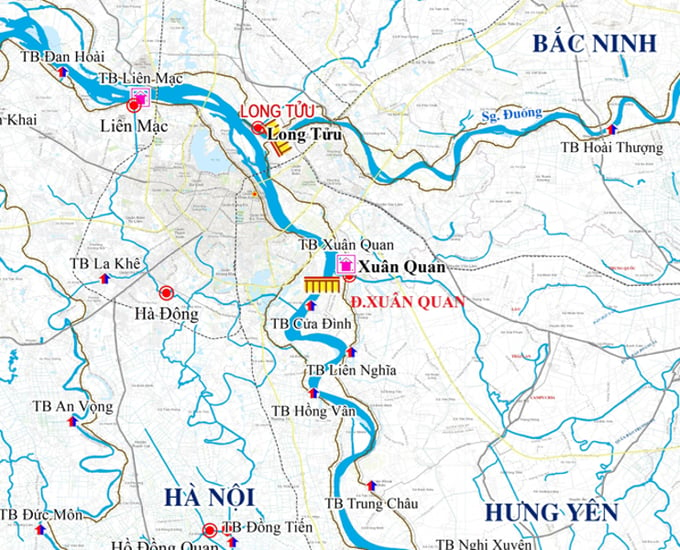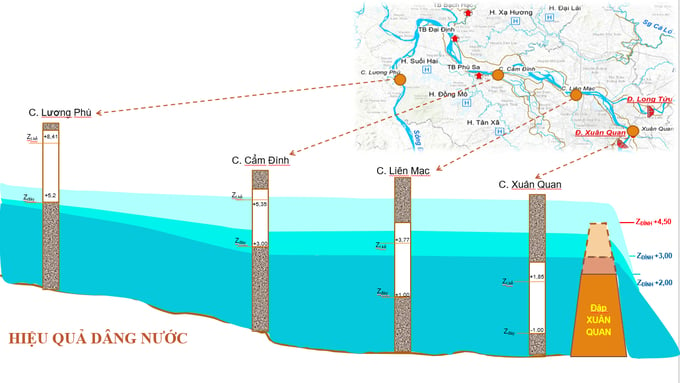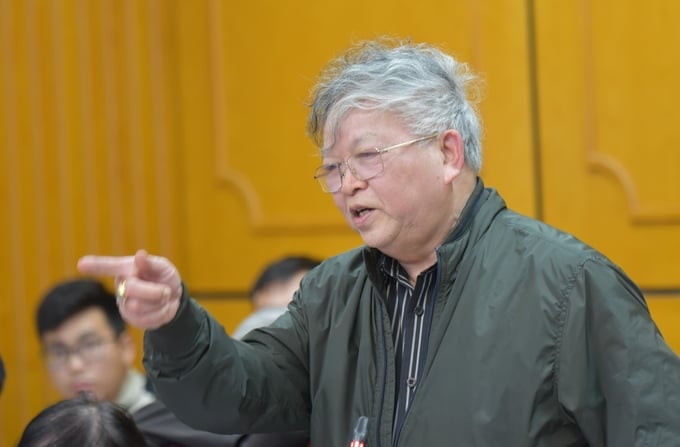November 19, 2025 | 16:38 GMT +7
November 19, 2025 | 16:38 GMT +7
Hotline: 0913.378.918
November 19, 2025 | 16:38 GMT +7
Hotline: 0913.378.918
At the Workshop on Solutions to Ensure Water Security in Western Hanoi, organized by the Vietnam National Committee on Large Dams and Water Resources Development (VNCOLD) in collaboration with the Institute of Water Resources Planning and the National Science and Technology Program KC.14/21-30 (Ministry of Science and Technology), scientists paid special attention to the issue of reviving the ‘dead’ rivers in western Hanoi.

Mr. Do Van Thanh, former Director of the Institute of Water Resources Planning. Photo: Minh Phuc.
Speaking on behalf of the Institute of Water Resources Planning, Mr. Do Van Thanh stated that previous irrigation plans had approved the construction of two dams – one on the Red River and another on the Duong River. These dams aim to prevent water levels from dropping too low, ensuring a steady water supply for the Nhue and Day Rivers. The plan also includes renovating major irrigation systems, including Phu Sa, Day River, Nhue River, and Tich River, to support irrigation for nearly 80,000 hectares of farmland.
Regarding the calculation of dam elevations on the Red River, Mr. Thanh and his team conducted surveys at Xuan Quan and Long Tuu sluices. They concluded that the most suitable location for the Xuan Quan Dam on the Red River is about 1 km downstream of Xuan Quan sluice. Meanwhile, the Long Tuu Dam on the Duong River would be built approximately 11 km from Long Tuu sluice, near the upstream section of Phu Dong Bridge.

The Institute of Water Resources Planning proposed the location to build Xuan Quan dam on the Red River and Long Tuu dam on the Duong River. Photo: Minh Phuc.
“We calculate the dam elevation at many different levels. Specifically, with current conditions, if we build Xuan Quan dam at an elevation of +2m, we can only solve the problem of supplying water to Bac Hung Hai river through Xuan Quan sluice and partially bring water to Lien Mac sluice (the source of Nhue river). As for the dam elevation of +3m, we still cannot bring water to Cam Dinh sluice (the source of Day river). If we build the dam at an elevation of +4.5m, it will provide enough water for Xuan Quan sluice at 80m3/s, Lien Mac sluice at 36m3/s, Cam Dinh sluice at 36m3/s, and Luong Phu sluice at 5-7m3/s.
If Xuan Quan dam is built at an elevation of +6m, it will solve the problem completely, including Luong Phu sluice (with a flow rate of 26 - 28m3/s). However, due to the problem of flood drainage and concerns about the impact of salinity in the downstream area, the Institute of Water Resources Planning chose the solution of building a dam at an elevation of +4.5m.

Model of water level rise efficiency at Xuan Quan sluice, Lien Mac sluice, Cam Dinh sluice, Luong Phu sluice when building Xuan Quan dam corresponding to dam elevations of +2m, +3m and +4.5m. Photo: Minh Phuc.
In particular, when the dam is completed, it will increase the ability to take water into the Nhue River, Day River, and Tich River, contributing to improving the environment and reviving the rivers. In addition, the entire Red River will become a very large open surface, which can develop tourism and landscapes, without being exhausted and exposed to the bottom," Mr. Do Van Thanh shared.
Regarding the plan to build Thuan My dam on Da River (of the VNCOLD) to transfer water into Tich River and invest in works to regulate and lead water from Tich River to supply Day River, Nhue River, To Lich River, Mr. Do Van Thanh said that previously, some scientists such as Professor Tran Dinh Hoa and Professor Pham Hong Giang had researched and proposed to build a dam here. In the recent irrigation planning, we have not included this content.
However, the VNCOLD agrees with the policy of building Thuan My dam on Da river, because the cost is low and does not have much impact downstream, and can raise the water level combined with hydropower according to the requirements of the electricity industry. As for transferring water from Tich river to Day river, Nhue river, To Lich river to “revive” inner-city rivers, it is necessary to continue to study, evaluate, ensure economic and technical feasibility and related impacts.
Regarding the plan to build a dam on the Red River, Professor Dao Xuan Hoc, Chairman of the Vietnam Irrigation Association, said that when building a dam at an elevation of +4.5m, the Institute of Irrigation Planning confirmed that water could be taken into the Nhue River, the Day River and the Bac Hung Hai River. However, the pumping stations above such as Trung Ha, Son Da (on the Da River), Bach Hac, Dai Dinh and the main works along the Thao River and the Lo River have not yet been able to take water. That is an issue we must consider.

Professor Dao Xuan Hoc said that it is necessary to study the construction of Xuan Quan dam on the Red River with a minimum height of 6m to solve the problem of proactive water sources for the Tich River, Nhue River, Day River and Bac Hung Hai. Photo: Minh Phuc.
“When advising the Institute of Water Resources Planning, I gave my personal opinion that it is necessary to calculate the construction of a dam with a minimum height of +6m to ensure that Thuan My sluice can also take 28m3/s into the Tich River”. Professor Hoc further analyzed that the reason why Hanoi previously built Thuan My sluice with a design of 60m3/s was because it wanted to supplement the water source to replace the water source of Dong Mo - Ngai Son lake to serve the water supply for 16,000 hectares of agricultural production. Thereby, keeping the water level of Dong Mo - Ngai Son lake always stable, not affecting the Cultural - Tourism Village of Vietnamese ethnic groups.
But, with the current situation, he affirmed that the irrigation area replacing Dong Mo - Ngai Son lake is no longer 16,000 hectares, but has been greatly reduced, due to land being taken for projects to build the National University and urban development projects. Therefore, the actual water demand of the Tich River is not substantial.
Besides, after completing the construction of Xuan Quan dam at a minimum elevation of +4.5m on the Red River, it is completely possible to supply water to Nhue River and Day River, so there is no need to raise the issue of taking water from Da River to supply Nhue River and Day River via Tich River anymore, because the distance is too far.
Regarding the opinion of the Institute of Water Resources Planning that building a 6m high Xuan Quan dam will affect saline intrusion downstream, Professor Dao Xuan Hoc frankly expressed: “I am very surprised by this opinion of the planners. Because, saline intrusion is related to how much water is released downstream, not how high the dam is. Those are two very different issues. If we coordinate with the electricity industry to release the appropriate amount of water, ensuring environmental flow, then it is completely possible to push back salinity in the downstream area.”
Regarding the plan to build a dam on the Da River to take water through the Thuan My sluice with a flow rate of 100m3/s, then divide the water into the Bui River, Day River, Nhue River, and To Lich River, Dr. To Van Truong said that although the above plan correctly calculated the hydraulics to transfer water from the Da River to the four rivers, the loss of water resources along the way (about 70km) is very large, so it needs to be recalculated more carefully.

Dr. To Van Truong believes that we need to invest without regret to revive rivers. Photo: Minh Phuc.
After studying all the options for providing self-flowing water for rivers, Dr. To Van Truong concluded that the options overlap. A nindependent research topic of Professor Tran Dinh Hoa conducted a long time ago (before 2010) also proposed building dams on the Duong River, the Red River and the Da River. However, the option to build a dam on the Da River of the VNCOLD is more detailed. Therefore, the issue that needs to be addressed now is to have a presiding agency, gathering research, information sources and documents so that we can inherit, have lessons learned, and solve the overall, long-term problem.
“When humans impact nature, there are always gains and losses; we never get everything. So now we have to research how we can gain the most benefit and lose the least. If from this angle or that angle, there are people who object, that is just one perspective. The decision maker must know how to synthesize, must understand the previous problems to analyze, evaluate and choose,” Dr. To Van Truong shared.
Translated by Quynh Chi

(VAN) Agricultural extension officers in Quang Ninh do more than transmit knowledge; they have become a steadfast support system for farmers on the path to sustainable agricultural development.

(VAN) The development of a high-quality beef cattle herd has brought major benefits to livestock farmers, creating jobs and enabling better use of agricultural by-products.

(VAN) In the eastern region of Gia Lai, crossbred cattle now account for 93%, forming a high-quality beef herd and establishing a recognized brand, the result of 35 years of persistent effort.

(VAN) Integrating agricultural extension activities with ecotourism development unlocks promising new avenues for localities boasting specific advantages in grape and apple cultivation.

(VAN) Enterprises and cooperatives accompany farmers in Tay Ninh to develop an organic seedless lime growing area, paving the way for poverty reduction.

(VAN) There were times when Pho faltered, yet his aspiration to bring the pure aroma to those who truly value clean tea kept urging him forward.

(VAN) Bich Thao Coffee Cooperative pioneered products achieving the national 5-star OCOP standard, paving the way for Son La coffee to conquer international markets.